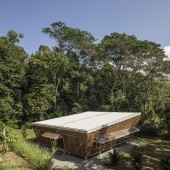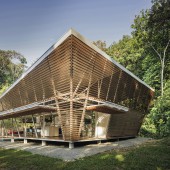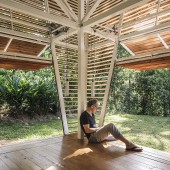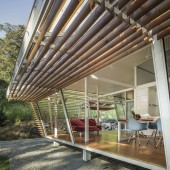No Footprint House Residential Prototype by Oliver Schutte |
Home > Winners > #104782 |
 |
|
||||
| DESIGN DETAILS | |||||
| DESIGN NAME: No Footprint House PRIMARY FUNCTION: Residential Prototype INSPIRATION: The No Footprint House, or simply NFH, has numerous inspirations. It is largely rooted in the work of professionals who were looking for combined solutions in architecture and engineering, further paired with a broader world view towards sustainable development. For example, the Dymaxion House by Buckminster Fuller was a crucial influence for us, as well as the groundbreaking work of Jean Prouve in terms of his prefabricated systemic designs for different climates, such as the Maison Tropicale. Further inspiration was found in the contemporary automotive industry. UNIQUE PROPERTIES / PROJECT DESCRIPTION: The prototype of the No Footprint House is located along the southern Pacific coast of Costa Rica. Placed in a humid tropical climate, the building design responds to its surrounding habitat by passive climate control through natural ventilation and solar shading. The inclined facade panels can be opened or closed individually in order to regulate views and exposure, augment or reduce air flows, create privacy and security. They convert interior to exterior spaces and play with the dynamic among nature and the built environment, one of the key features of tropical architecture. OPERATION / FLOW / INTERACTION: In its initial phase, the NFH comes in three different sizes that can be auto-configured with regards to the internal distribution and connections, material finishes and desired level of services: from tiny to mid-size and family home. Tailor-made typologies can be offered, including self-sufficient solutions for off-grid locations. The selection of all elements and materials from our catalog of prefabricated components is based on a thorough investigation regarding their origin, processing, cost and environmental footprint. They can be chosen according to the site-specific requirements and client needs. PROJECT DURATION AND LOCATION: The NFH is an ongoing project. The prototype in Costa Rica was designed and developed in 2017. It was brought to and tested on site in 2018, documented and communicated in 2019. Since then, we have been working on additional component designs and material solutions to enrich the NFH toolbox and to create solutions for a broad customer segment. With further improvements to the building and operational logistics, we expect to become carbon-neutral by 2021. As of 2022, we intend to extend the production in order to export to other countries while continuing to deliver for the home market in Costa Rica. |
PRODUCTION / REALIZATION TECHNOLOGY: The project is based on a prefabricated component design system. A first prototype was built with a structural steel frame and pine wood finishes. It was prefabricated in the Central Valley of Costa Rica and delivered to its target-site on one single truck. We are currently developing additional structural systems in order to amplify the configuration options for our clients and to continue improving the project performance. One of these alternative systems is based on laminated and solid teak wood components, which will be produced and processed in Costa Rica. The different product lines will become available as of 2021. SPECIFICATIONS / TECHNICAL PROPERTIES: The built prototype is based on a structural grid size of 12x9 meters, which are broken down into prefabricated units of 3x3 meters each. The central service core measures 6x3 meters, containing 2 bathrooms and all technical equipment of the house. With cantilevering and double-height floor areas, the building totals 150 square meters for two bedrooms, kitchen, dining, living and terrace areas. It is designed as a spacious residence for one family. Alternative pre-designed typologies for individuals and small families are available. Individual layouts can be configured and produced upon demand. TAGS: Climate Action, Climate Change, Net Zero, New Urban Agenda, New Rural Agenda, Sustainable Construction, Tropical Modernism, Well Being RESEARCH ABSTRACT: The NFH has a dual agenda: on the one hand, we investigate how to lower the environmental impact and greenhouse gas emissions of construction for new and existing buildings. On the other hand, we develop and offer a commercial product in different configurations. The correlation of these parallel dynamics is key for the success of the overall project. Our research was presented on international platforms such as the 2019 UN climate conferences in Spain and Costa Rica. At the same time, we launched the documentation of the first built prototype, which we are continuously improving for serial production. CHALLENGE: The main challenge is to systematize the existing building components that are available on the local construction market. These components are then augmented with imported and self-made solutions to resolve crucial design issues. In the case of the prototype, this was specifically relevant with regards to the inclined bi-fold doors in order to achieve the characteristic and interactive "wrap" or "skin" of the building. Further challenges were related to the water and energy management system of the project, as well as the prefabrication logistics and on-site delivery. ADDED DATE: 2020-03-31 02:07:44 TEAM MEMBERS (10) : Lead architect: Oliver Schütte / A-01, Design team: José Pablo González / A-01, Misael Rodríguez / A-01, Ronald Carvajal Soto / A-01, Mauricio Rodríguez / A-01, Market research: Marije van Lidth de Jeude / A-01, Structural and electro-mechanical engineering: Rafael Cañas / Ingeniería Cañas, Life cycle assesment: Pablo Mora / Consost, Construction: Hernán Mora / SLO Studiolocal and Collaborator: Luuc van Wezel / Villas Gaia IMAGE CREDITS: Photography: Fernando Alda Video: Manduca Audiovisual PATENTS/COPYRIGHTS: All rights reserved: A-01 (A Company / A Foundation) |
||||
| Visit the following page to learn more: http://www.a-01.net | |||||
| AWARD DETAILS | |
 |
No Footprint House Residential Prototype by Oliver Schutte is Winner in Sustainable Products, Projects and Green Design Category, 2019 - 2020.· Press Members: Login or Register to request an exclusive interview with Oliver Schutte. · Click here to register inorder to view the profile and other works by Oliver Schutte. |
| SOCIAL |
| + Add to Likes / Favorites | Send to My Email | Comment | Testimonials | View Press-Release | Press Kit | Translations |







